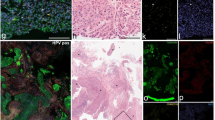Summary
A microfluorometric method was used to determine the nuclear DNA content in the nasopharyngeal carcinomas (NPC) of 25 patients treated before 1983. Eleven patients are still alive with no evidence of disease (NED), while the rest died of their disease (DOD). All of the patients received a cycle of radiotherapy, while some also received chemotherapy or neck dissections. The neoplastic cells studied were taken from the original biopsy blocks, deparaffinized, isolated by enzymatic treatment and mechanical fragmentation, and then Feulgen-stained. The cytofluorometric measurement was carried out by a microphotometer equipped for fluorescence excitation and connected to a computer. This method allowed us to construct a histogram of the DNA content in the neoplastic cells. Different neoplastic classes were identified and represent the heteroclonality of the tumor, which can be expressed by the heteroclonality index (HCT). From the collected data it appears that the NED patients all had a low HTC (<1) and only 7 of the DOD patients had low HTCs (<1). Six of the DOD patients with a low HTC were in advanced stages of their tumor at the time of diagnosis, while the remaining patient did not complete his treatment. Our results show that the DNA analysis of the NPC cell population may offer a useful tool in predicting the biological behavior of this tumor and also improving its treatment.
Similar content being viewed by others
References
Atkin NB (1976) Prognostic significance of ploidy level in human tumors I. Carcinoma of the uterus. J Natl Cancer Inst 56:909–910
Benson RC, Meyer RA, Zaruba ME, McKhann GM (1979) Cellular autofluorescence. Is it due to flavins? J Histochem Cytochem 27:44–48
Bohm N, Sprenger E (1968) Fluorescence cytophotometry: a valuable method for the quantitative determination of nuclear Feulgen DNA. Histochemie 16:100–118
Chieco P, Melchiorri C, Lisignoli G, Marabini A, Orlandi C (1987) Studio dell'instabilità genetica del carcinoma ovarico tramite citofluorimetria del DNA. I tumori dell'ovaio. In: Monduzzi G (ed) Atti del Convegno Internazionale “I tumori delle gonadi”, Ancona, vol V, pp 83–89
Duijiam WAL, Van Duijin P (1975) The influence of chromatin compactness on the stoichiometry of the Feulgen-Schiff procedure studied in model films. II. Investigations on films containing condensed or swollen chicken erythrocyte nuclei. J Histochem Cytochem 23:891–900
Giangaspero F, Chieco P, Lisignoli G, Burger PC (1987) Comparison of cytologic composition with microfluorometric DNA analysis of the glioblastoma multiforme and anaplastic astrocytoma. Cancer 60:59–65
Hedley DW, Friedlander ML, Taylor IW, Rugg CA, Musgrove EA (1983) Method for analysis of cellular DNA content of paraffin-embedded pathological material using flow-cytometry. J Histochem Cytochem 31:1333–1335
Heppner GH (1984) Tumor heterogeneity. Cancer Res 44:2259–2265
Iversen OE, Laerum OD (1985) Ploidy disturbances in endometrial and ovarian carcinomas. Anal Quant Cytol Histol 7:327–336
Krueger GRF, Wustrow J (1981) Current histological classification of nasopharyngeal carcinoma at the Cologne University. In: Grundman E, Krueger GRA, Ablashi DW (eds) Cancer compaign, nasopharyngeal carcinoma, vol 5. Fisher, Stuttgart, pp 11–15
Moberger B, Auer G, Forsslund G, Moberger G (1984) The prognostic significance of DNA measurements in endometrial carcinoma. Cytometry 5:430–436
Prenna G, Leiva S, Mazzini G (1974) Quantitation of DNA by cytofluorometry of the conventional Feulgen reaction. Histochem J 6:467–489
Shapiro JR, Yung WA, Shapiro WR (1981) Isolation karyotype and clonal growth of heterogeneous subpopulations of human malignant gliomas. Cancer Res 41:2344–2359
Takamatsu T, Nakanishi K, Onouchi Z, Fukuda M, Fujita S (1980) Nonspecific (pseudo-plasmal) dye binding in the Feulgen nuclear stain and its blocking by Azocarmin. J Histochem 66:169–180
Author information
Authors and Affiliations
Rights and permissions
About this article
Cite this article
Caliceti, U., Rinaldi Ceroni, A., Lisignoli, G. et al. The use of microfluorometry to study DNA in nasopharyngeal carcinomas: a possible prognostic tool?. Arch Otorhinolaryngol 246, 365–367 (1989). https://doi.org/10.1007/BF00463596
Issue Date:
DOI: https://doi.org/10.1007/BF00463596




